The AMD A8-7670K APU Review: Aiming for Rocket League
by Ian Cutress on November 18, 2015 8:00 AM ESTGaming Benchmarks: Low End
To satisfy our curiosity regarding low-power gaming, as well as dual graphics arrangements, we ran our regular suite through each processor. On this page are our integrated graphics results, along with a cheaper graphics solution in the R7 240 DDR3 and, in the case of AMD, both of these together in dual graphics mode.
Alien: Isolation
If first-person survival mixed with horror is your sort of thing, then Alien: Isolation, based off of the Alien franchise, should be an interesting title. Developed by Creative Assembly and released in October 2014, Alien: Isolation has won numerous awards, ranging from Game Of The Year to several top 10s/25s and Best Horror titles, ratcheting up over a million sales by February 2015. Alien: Isolation uses a custom-built engine that includes dynamic sound effects and should be fully multicore enabled.
For low-end graphics, we test at 720p with Ultra settings, whereas for mid- and high-range graphics, we bump this up to 1080p, taking the average frame rate as our marker with a scripted version of the built-in benchmark.

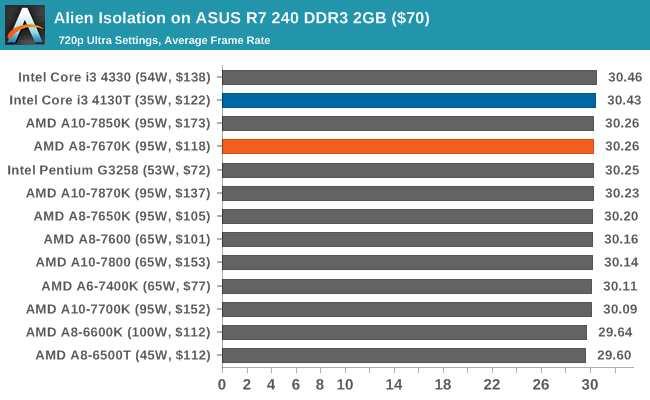
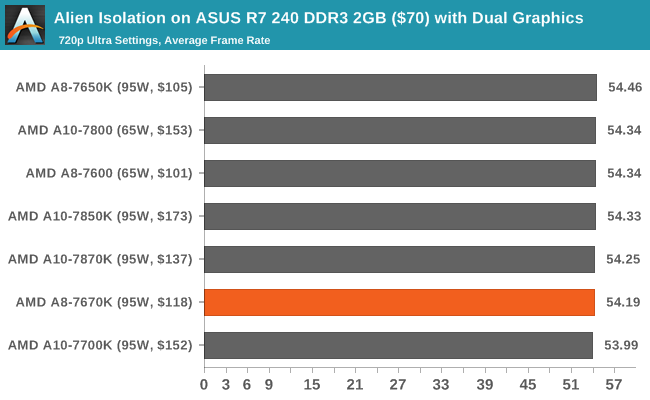
Total War: Attila
The Total War franchise moves on to Attila, another Creative Assembly development, and is a stand-alone strategy title set in 395AD where the main story line lets the gamer take control of the leader of the Huns in order to conquer parts of the world. Graphically, the game can render hundreds/thousands of units on-screen at once, all with their individual actions, and can put some of the big cards to task.
For low-end graphics, we test at 720p with performance settings, recording the average frame rate. With mid- and high-range graphics, we test at 1080p with the quality setting. In both circumstances, unlimited video memory is enabled, and the in-game scripted benchmark is used.
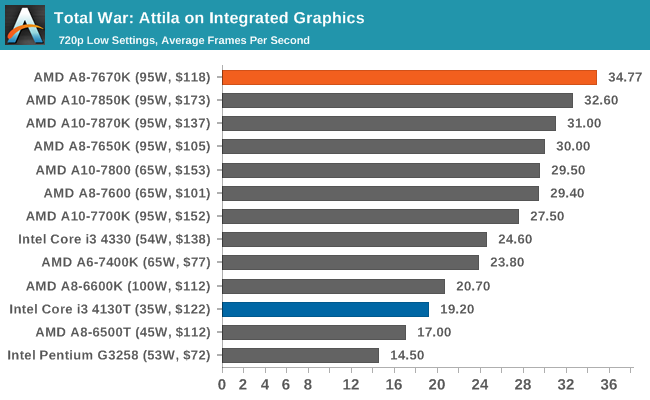

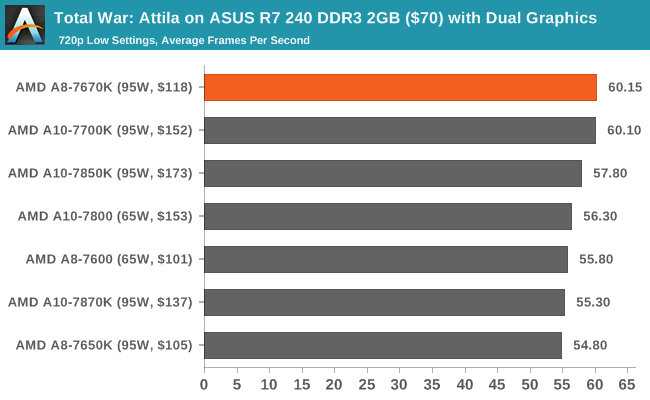
Grand Theft Auto V
The highly anticipated iteration of the Grand Theft Auto franchise finally hit the shelves on April 14, 2015, with both AMD and NVIDIA in tow to help optimize the title. GTA doesn’t provide graphical presets, but it opens up the options to users and extends the boundaries by pushing even the hardest systems to the limit using Rockstar’s Advanced Game Engine. Whether the user is flying high in the mountains with long draw distances or dealing with assorted trash in the city, when cranked up to maximum, it creates stunning visuals but hard work for both the CPU and the GPU.
For our test, we have scripted a version of the in-game benchmark, relying only on the final part, which combines a flight scene with an in-city drive-by, followed by a tanker explosion. For low-end systems, we test at 720p on the lowest settings, whereas mid- and high-end graphics play at 1080p with very high settings across the board. We record both the average frame rate and the percentage of frames under 60 fps (16.6 ms).

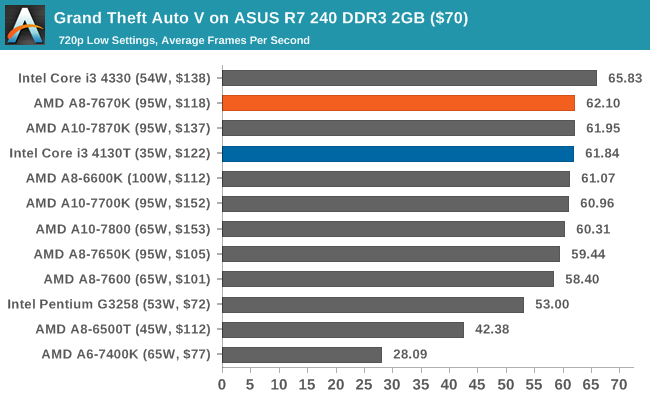
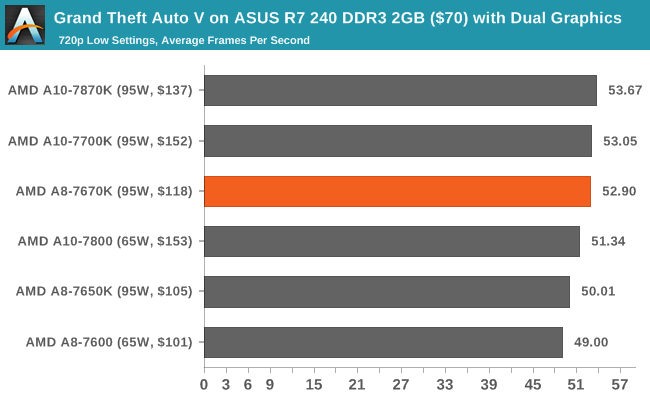
GRID: Autosport
No graphics test is complete without some input from Codemasters and the Ego engine, which means for this round of testing, we point toward GRID: Autosport, the next iteration in the GRID and racing genre. As with our previous racing testing, each update to the engine aims to add in effects, reflections, detail and realism, with Codemasters making "authenticity" a main focal point for this version.
GRID’s benchmark mode is very flexible, and as a result, we created a test race using a shortened version of the Red Bull Ring with 12 cars doing two laps. The player car is in focus throughout this benchmark and starts last, but usually finishes second or third. For low-end graphics, we test at 1080p and medium settings, whereas mid- and high-end graphics get the full 1080p maximum. Both the average and the minimum frame rates are recorded.
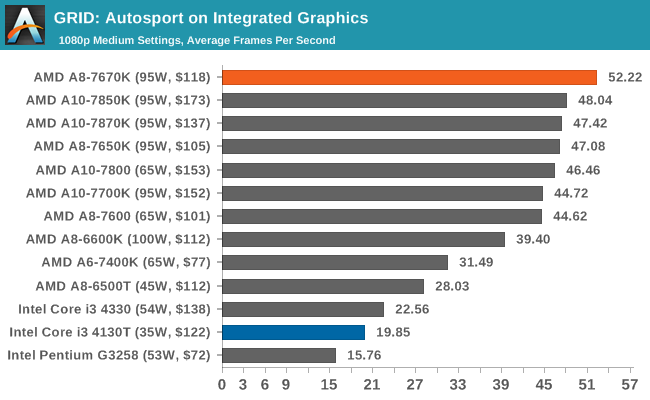
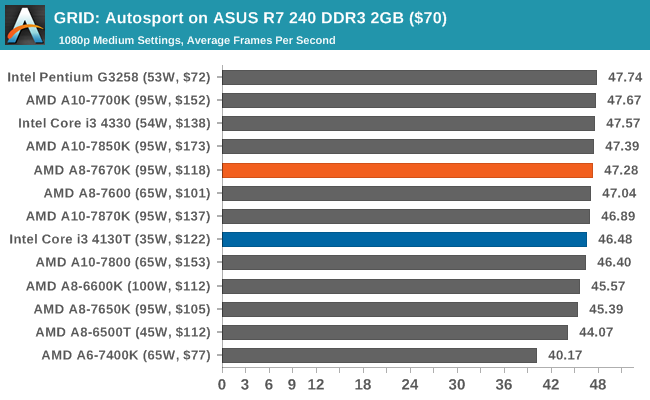
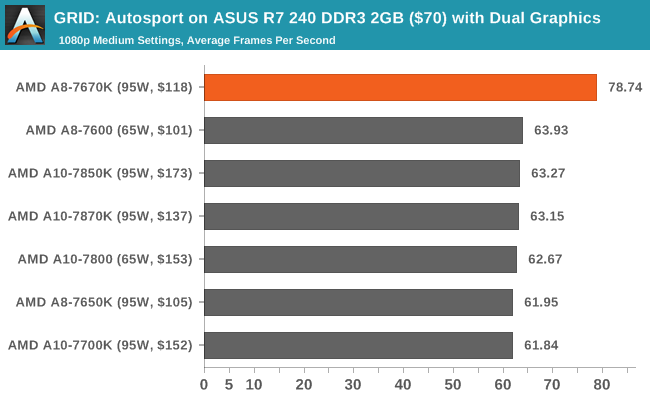
For whatever reason, the A8-7670K gets a good showing in the integrated tests, especially in dual graphics mode, with an abnormally high score. Some other issue might be at play here and warrants further testing.
Middle-Earth: Shadows of Mordor
The final title in our testing is another battle of system performance with the open-world action-adventure title Shadow of Mordor. Produced by Monolith using the LithTech Jupiter EX engine and numerous detail add-ons, SoM goes for detail and complexity to a large extent, despite having to be cut down from the original plans. The main story was written by the same writer as Red Dead Redemption, and it received Zero Punctuation’s Game of The Year in 2014.
For testing purposes, SoM gives a dynamic screen resolution setting, allowing us to render at high resolutions that are then scaled down to the monitor. As a result, we get several tests using the in-game benchmark. For low-end graphics, we examine at 720p with low settings, whereas mid- and high-end graphics get 1080p Ultra. The top graphics test is also redone at 3840x2160, also with Ultra settings, and we also test two cards at 4K where possible.
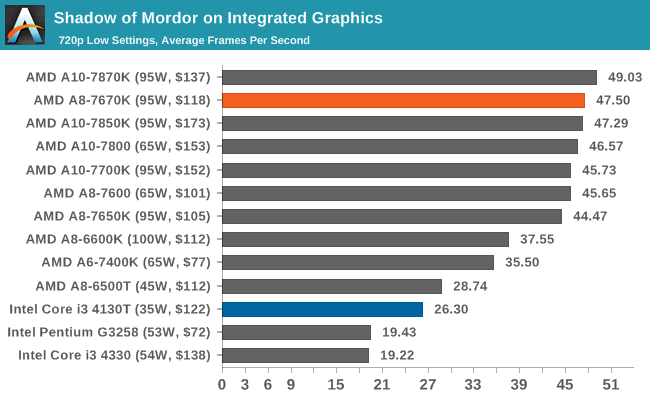
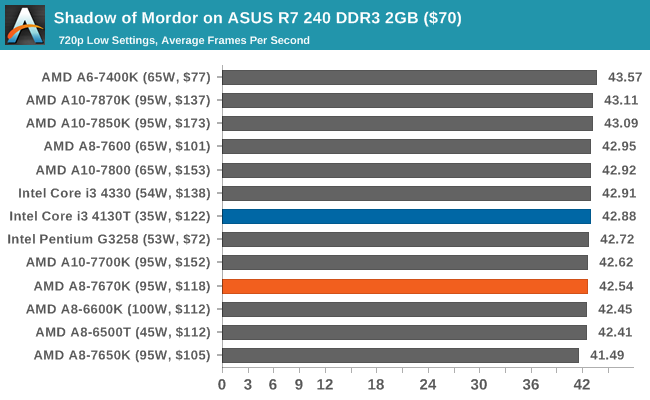
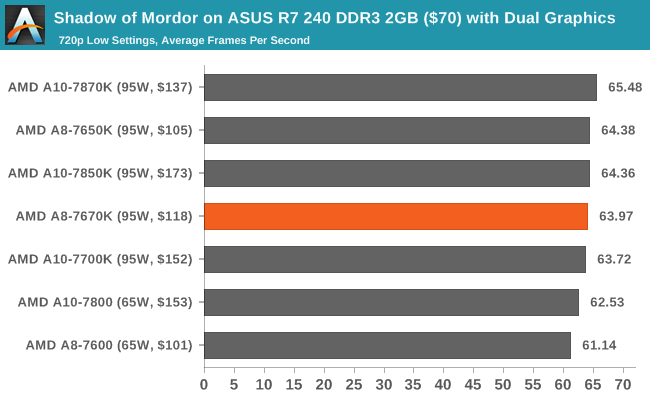















154 Comments
View All Comments
Linuxenthusiast - Thursday, November 26, 2015 - link
I think one of the main problems for AMD is that there are very few brand name computers using the faster AMD APUs in the stores. That, combined with all the people that think they “have” to have an Intel processor because it's “better” works against AMD.I have been building desktops for friends and family and friends of friends with AMD cpus exclusively for the past 20 years and AMD APUs for the past four years or so. All the PCs used either the integrated chipset AMD video or the APUs integrated video. I can build a sturdier, longer lasting PC, with higher quality parts at a lower price than brand name PCs by using AMD APUs and motherboards. I basically build them the PCs that they can't buy in the stores.
Most of the users have been web browser/email/YouTube/photos/music users and have been very happy with the price and performance of the PCs and have no idea what they are supposedly “missing” by not having the additional costs of an Intel cpu and motherboard. If you judge the performance of the PC by how well it handles typical multithreaded everyday apps rather than benchmarks, I think you will find that AMD APUs are more than adequate for most users.
In the past year or so, I've built 5 PCs for teenage or twenty-something Windows gamers and one mid-forties gamer who has $500+ invested in a fancy “race-car” seat and pedals and gear shift that feel like ones in a real race car. The race car gamer didn't believe that the AMD APU alone could provide sufficient video performance without an additional add-in video card, but I convinced him to try it with the idea that we could always add a video card later, if he needed it.
Well, much to his surprise, the Kaveri AMD APU was more than adequate for his needs and he's quite happy with it.
The teenagers and twenty-somethings are also using only the IGP of the Kaveri APUs and they are all quite pleased with the performance of the PCs. None of them have asked for an add-in video board. I don't think any of them are playing the most demanding games at the highest possible settings, but the main point is that they are all quite happy with the performance of their PCs and all of them are using the IGP of the Kaveri APUs.
Every time someone thinks they need an Intel cpu, I have been able to convince them to try a PC with an AMD APU and no one has ever been disappointed with the performance of the APU PCs.
I also try to recommend notebooks with AMD APUs and I wish there were more APU-based Thinkpads as well as more APU based Lenovos and HPs and the people who've bought them are also quite happy with their performance.
I would encourage people who've never used AMD APUs to give the current Kaveri and later APUs a try. It won't cost much and I think you'll be pleasantly surprised.
Vesperan - Wednesday, November 18, 2015 - link
I've been pleasantly surprised by what a 7850K (at 2133mhz memory) can achieve. 5-10 years ago I would have said gaming on integrated is impossible, but now you can do a lot on them.That said - I've definately avoided some titles until I get a graphics card.
CaedenV - Wednesday, November 18, 2015 - link
And this is the kicker... even you will still need a dGPU in the end. An APU is either for a non-gaming system that could easily get by with Intel iGPU level graphics; or it is a stop-gap until you can afford a dGPU, after which point the APU is going to be your bottleneck for the rest of it's life. Far better (at least in my opinion) to start with the CPU you want in the long term, limp along with the iGPU until you can find a good GPU on sale.Over the 5-10 year life of a modern computer, what is 3-6 months to scrape together the money for a GPU?
Vesperan - Thursday, November 19, 2015 - link
I'm an outlier (as is anyone reading/posting here) but for me the 7850k is a combination of a few things - supporting AMD as the smaller company, but also recognising my needs. The integrated graphics are perfectly fine for my current gaming needs and I would rather spend the money on a discrete GPU in 2016 when the new process node/GPUs are out than now. I also have two young children so I'm lucky to get 30 min a day on the desktop!Money isnt the issue but like every geek here we need to have a build that is optimal in some way. But yes - when I set out to built an AMD system that made sense I really, really struggled to justify it. Its not only the weakness of the CPU, but the high TDPs relative to performance. Fighting back at Intel while being two process nodes behind is just terrible for AMD.
BlueBlazer - Wednesday, November 18, 2015 - link
Potential buyers would most likely choose either Intel's LGA115x or AMD's AM3+ platform for gaming builds, and overlook/ignore AMD's dead-end FM2/FM2+ platform. That is very much due to future upgradeability considerations, especially the CPU (where AMD's FM2/FM2+ platform is limited to 4 "cores"). Install a powerful discrete GPU and AMD's APU will bottleneck it (which is why a faster CPU is required)...abufrejoval - Wednesday, November 18, 2015 - link
I have come to respect APUs in my main home server. It started with an A10-5800K Trinity APU some years ago, 32GB of RAM and 16TB of RAID6 storage, but when I saw an A10-6700 Richland APU cheap on eBay I swapped it for reduced idle power (22Watts now).It's been running pretty much non-stop for years, and because it's so super quiet I find that most of the time I rather use it for pretty much everything from surfing, to taxing and video rather than wake my heavy dGPU Intel game rig from standby.
It typically runs Windows 2008R2 and then quite a few VMs using VMware workstations and dual monitors.
The original motive was flexibility: 8 SATA ports, 32GB of RAM, full IOMMU/VT-d capabilities, 3 4-16 lane PCIe slots and sufficient graphics power on a very low power and financial budget simply couldn't be had from Intel at the time.
With Skylake Xeons equivalent flexibility and capabilities are starting to appear, while of course it vastly exceeds the APU's performance on some (for me not critical) aspects, but also comes at a significantly different price.
My main disappointments so far have been:
Lack of ECC support with the FM2(+) sockets (I froth at the mouth whenever I think about that stupid cost cutting omission)
Kaveri idle power performance much worse than Richland
Missing Carrizo socket SKU with ECC DDR4 RAM
Missing "game cartidge" variant e.g. with 8GB of GDDR5 soldered on a dGPU form factor PC designed for a passive PCIe backplane, expandable from 1-4 stackable APUs
CaedenV - Wednesday, November 18, 2015 - link
I too am running an A10 5800K CPU for my home server at the moment... but it is because I got it for free (PCIe slot burned out, and my friend didn't want it anymore). But had I been buying an A10 vs a Pentium or i3 for home server use it would hands down be the Intel. Up front costs being equal, even a crappy Celeron is 'good enough' to run a home server as performance is decided by the HDDs and RAM. In the long run the Intel is going to run cooler, quieter, and on less power for a system that is on 24x7. This means lower power bills, less noise produced, less airflow needed, and less dust accumulation.It is not that the AMD is bad as a home server platform (mine has been running great for quite a while now), it is simply not as good. Heck, even with it being free I am considering replacing it next year with an intel system simply because it will pay for itself in power costs alone in just a few years. So even free AMD vs paying for Intel is a toss-up.
DiHydro - Friday, December 4, 2015 - link
It's going to be hard to pay off a new system with a difference of $16 a year, and that is at 50% CPU 24/7, which is extremely high for a home server.Computer Bottleneck - Wednesday, November 18, 2015 - link
Eight 6 Gbps SATA ports on A88X is pretty sweet, but yes it would be great to see ECC on this platform as well. Also more Mini-ITX FM2+ boards.spinportal - Wednesday, November 18, 2015 - link
That's a power hungry bugger that trades blows with the i3 4130T, but not acceptable TDP for a laptop or NUC. Nice try, but misses the mark as a desktop chip or a mini-platform.